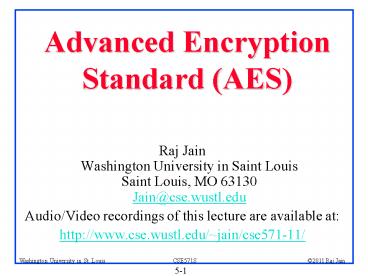Advanced Encryption Standard (AES) - PowerPoint PPT Presentation
1 / 17
Title:
Advanced Encryption Standard (AES)
Description:
Show the value of State after MixColumns. Lab Homework 4 This homework requires two computers with OpenSSH and telnet client and servers installed. – PowerPoint PPT presentation
Number of Views:3763
Avg rating:3.0/5.0
Title: Advanced Encryption Standard (AES)
1
Advanced Encryption Standard (AES)
- Raj Jain Washington University in Saint
LouisSaint Louis, MO 63130Jain_at_cse.wustl.edu - Audio/Video recordings of this lecture are
available at - http//www.cse.wustl.edu/jain/cse571-11/
2
Overview
- AES Structure
- AES Round Function
- AES Key Expansion
- AES Decryption
These slides are based on Lawrie Browns slides
supplied with William Stallings book
Cryptography and Network Security Principles
and Practice, 5th Ed, 2011.
3
Advanced Encryption Standard (AES)
- Published by NIST in Nov 2001 FIPS PUB 197
- Based on a competition won by Rijmen and Daemen
(Rijndael) from Belgium - 22 submissions, 7 did not satisfy all
requirements15 submissions 5 finalists Mars,
RC6, Rijndael, Serpent, Twofish. Winner
Rijndael. - Rijndael allows many block sizes and key sizes
- AES restricts it to
- Block Size 128 bits
- Key sizes 128, 192, 256 (AES-128, AES-192,
AES-256) - An iterative rather than Feistel cipher
- operates on entire data block in every round
- Byte operations Easy to implement in software
4
Basic Structure of AES
- Rounds Nr 6 maxNb, Nk
- Nb 32-bit words in the block
- Nk 32-bit words in key
- AES-128 10
- AES-192 12
- AES-256 14
5
1. Substitute Bytes
- Each byte is replaced by byte indexed by row
(left 4-bits) column (right 4-bits) of a 16x16
table
6
2. Shift Rows
- 1st row is unchanged
- 2nd row does 1 byte circular shift to left
- 3rd row does 2 byte circular shift to left
- 4th row does 3 byte circular shift to left
7
3. Mix Columns
- Effectively a matrix multiplication in GF(28)
using prime polynomial m(x) x8x4x3x1
8
AES Arithmetic
- Uses arithmetic in the finite field GF(28) with
irreducible polynomial - m(x) x8 x4 x3 x 1
- which is (100011011) or 11B
- Example
- 02 87 mod 11B (1 0000 1110) mod 11B
- (1 0000 1110) ? (1 0001 1011) (0001 0101)
9
4. Add Round Key
- XOR state with 128-bits of the round key
10
AES Key Expansion
- Use four byte words called wi. Subkey 4 words.
- For AES-128
- First subkey (w3,w2,w1,w0) cipher key
- Other words are calculated as follows
- wiwi-1 ? wi-4
- for all values of i that are not multiples of 4.
- For the words with indices that are a multiple of
4 (w4k) - RotWord Bytes of w4k-1 are rotated left shift
(nonlinearity) - SubWord SubBytes fn is applied to all four
bytes. (Diffusion) - The result rsk is XOR'ed with w4k-4 and a round
constant rconk (breaks Symmetry) - w4krsk ? w4k-4 ? rconk
- For AES-192 and AES-256, the key expansion is
more complex.
11
AES Example Key Expansion
12
AES Example Encryption
13
AES Example Avalanche
14
AES Decryption
- AES decryption is not identical to encryption
- But each step has an inverse
15
Summary
- AES encrypts 128 bit blocks with 128-bit, 192-bit
or 256-bit keys using 10, 12, or 14 rounds,
respectively. - Is not a Feistel cipher ÞAll 128 bits are
encrypted - Each round 4 steps of SubBytes, ShiftRows,
MixColumns, and AddRoundKey. - Last round has only 3 steps. No MixColumns.
- Decryption is not the same as encryption (as in
DES).Decryption consists of inverse steps.
16
Homework 5
- 5.4 Given the plaintext 0001 0203 0405 0607 0809
0A0B 0C0D 0E0F and the key 0101 0101 0101 0101
0101 0101 0101 0101 - Show the original contents of state, displayed as
a 4x4 matrix. - Show the value of state after initial
AddRoundKey. - Show the value of State after SubBytes.
- Show the value of State after ShiftRows.
- Show the value of State after MixColumns.
17
Lab Homework 4
- This homework requires two computers with OpenSSH
and telnet client and servers installed. You can
use CSE571XPC2 client and CSE571XPS server or
your own computers. - Start wireshark on the client machine.
- telnet to the server and login with your username
and password. Logout. - Use follow the TCP stream option (right click
on the packet) to see your username and password
on the screen. Capture the screen and circle your
password. - ssh to the server and login with your username
and password. Logout. - Stop wireshark and read the trace. Capture the
screen. Circle the password characters.Note the
difference in the two logins?
18
Thank You!
19
Solution to Homework 5
- 5.4 Given the plaintext 0001 0203 0405 0607 0809
0A0B 0C0D 0E0F and the key 0101 0101 0101 0101
0101 0101 0101 0101 - Show the original contents of state, displayed as
a 4x4 matrix. - Show the value of state after initial
AddRoundKey. - Show the value of State after SubBytes.
- Show the value of State after ShiftRows.
- Show the value of State after MixColumns.

